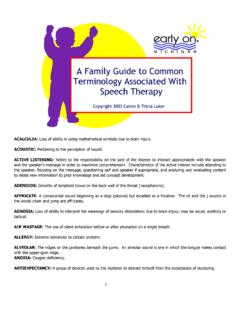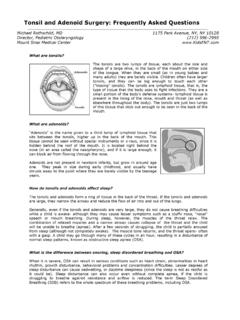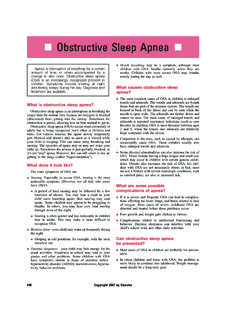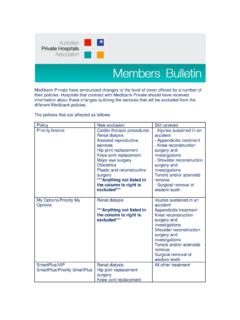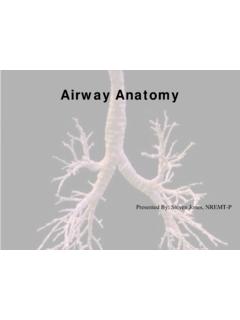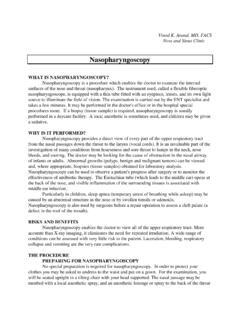Transcription of Eustachian Tube Problems - Michigan Ear Institute ...
1 Michigan Ear InstituteEustachianTube BOOK Eustachian Tube 12/13/18 10:36 AM1 Dennis I. Bojrab, MDSeilesh C. Babu, MDJohn J. Zappia, MD, FACSEric W. Sargent, MD, FACSE leanor Y. Chan, MDRobert S. Hong, MDIlka C. Naumann, MDCandice C. Colby, MDChristopher A. Schutt, MDProvidence Medical Building30055 Northwestern HighwaySuite 101 Farmington Hills, MI 48334 Beaumont Medical Building3555 W. Thirteen Mile RoadSuite N-210 Royal Oak, MI 48073 Oakwood Medical Building18181 Oakwood 402 Dearborn, MI 48126 Providence Medical Center26850 Providence ParkwaySuite 130 Novi, MI 48374248-865-4444 phone248-865-6161 faxDOCTORSLOCATIONS34015-56111-111 BOOK Eustachian Tube 12/13/18 10:36 AM3 WELCOMEW elcome to the Michigan Ear Institute , one of the nation s leading surgical groups specializing in hearing, balance and facial nerve disorders. The Michigan Ear Institute is committed to providing you with the highest quality diagnostic and surgical treatment highly experienced team of physicians, audiologists and clinical physiologists have established international reputations for their innovative diagnostic and surgical capabilities, and our modern, attractive facility has been designed with patient care and convenience as the foremost is our privilege to be able to provide care for your medical Problems and we will strive to make your visit to the Michigan Ear Institute a positive and rewarding BOOK Eustachian Tube 32/13/18 10:36 AM4 MECHANISM OF HEARING The ear is divided into three parts: an external ear, a middle ear and an inner ear.
2 Each part performs an important function in the process of external ear consists of an auricle and ear canal. These structures gather the sound and direct it to- ward the eardrum middle ear chamber lies between the external and inner ear. This air filled space is connected to the back of the throat by the Eustachian tube, which serves as a pressure equalizing valve. The middle ear contains three small ear bones (ossicles): the malleus (hammer), incus (anvil), and stapes (stirrup). These bones transmit sound vibrations to the inner ear. They act as a transformer, converting sound vibra-tions in the external ear canal into fluid waves in the inner ear. A disturbance of the Eustachian tube, eardrum or the bones may result in a conductive hearing loss. This type of impairment is usually cor-rectable medically or inner ear chamber contains the hair cells bathed in fluid. Inner ear fluid waves stimulate the hair cells. The information generated in these cells is transmit-ted to the brain through the hearing nerve where it is interpreted.
3 A disturbance in the inner ear fluids or nerve endings may result in a sensorineural (nerve) hearing impairment. This type of impairment is usu-ally not OF THE Eustachian TUBE The Eustachian tube is a narrow, one and a half inch long channel that connects the middle ear with the nasopharynx- the upper throat area just above the BOOK Eustachian Tube 42/13/18 10:36 AM5 Mastoid BoneThree Ear Bones (in middle ear)Balance Canals (in inner ear)Facial NerveBalance NerveHearing NerveHearing Canal (in inner ear) Eustachian TubeEar DrumBrainThe Eustachian tube functions as a pressure-equal-izing valve for the middle ear that is normally filled with air. When functioning properly, the Eustachian tube opens for a fraction of a second periodically (about once every three minutes) in response to swallowing or yawning. It allows air into the middle ear to replace air that has been absorbed by the middle ear lining (mucous membrane) or to equalize pressure changes occurring during altitude changes.
4 Anything that interferes with this periodic opening and closing of the Eustachian tube may result in hearing impairment or other ear or blockage of the Eustachian tube results in a negative middle ear pressure, with retraction (sucking in) of the eardrum membrane. In the adult, this is usually accompanied by some ear discomfort (a fullness or pressure feeling) and may result in a mild hearing impairment and head noise (tinnitus). There may be no symptoms in children. If the obstruction is prolonged, fluid may be drawn from the mucous membrane of the middle ear creat-ing a condition called serous otitis media (fluid in the middle ear).EXTERNAL MIDDLE EARINNER EAR34015-56111-111 BOOK Eustachian Tube 52/13/18 10:36 AM6 This occurs frequently in children in connection with upper respiratory infections and accounts for the hearing impairment associated with this TUBE Problems RELATED TO FLYING Individuals with a Eustachian tube problem may experience difficulty equalizing middle ear pressure when an aircraft ascends, outside pressure decreas-es, resulting in outward pressure on the eardrum.
5 When the aircraft descends, just the opposite occurs: atmospheric pressure increases and there is a rela-tive decrease in the middle ear pressure and inward pressure on the eardrum. Either situation may result in discomfort in the ear due to abnormal middle ear pressure if the Eustachian tube is not functioning properly. This discomfort more likely to occur upon aircraft avoid middle ear Problems associated with flying, you should not fly if you have an upper respiratory problem such as a common cold, allergy attack, or sinus infection. Should you have such a problem , or should you have a chronic Eustachian tube problem and must fly, it may help to avoid ear difficulty by observing the following recommendations:1. Begin taking an oral decongestant, such as Sudafed tablets, the day before your air flight. Continue the medication for twenty-four (24) hours after the flight if you have experienced any ear Following the container directions, begin the use of a nasal decongestant spray, such as Neosyn-ephrine, shortly before boarding the aircraft.
6 Should your ears plug up upon ascent, hold your nose and swallow. This will help suck excess air pressure out of the middle BOOK Eustachian Tube 62/13/18 10:36 AM73. Thirty minutes before the aircraft is due to land again use the nasal spray. Chew gum to stimulate swallowing. Should your ears plug up despite this, hold your nose and blow forcibly to try to blow air up the Eustachian tube into the middle ear (Valsalva maneuver).4. Drinking adequate amounts of fluid (ideally water) before and during the flight allow the lining of the Eustachian tube to function more Remember it is unwise to fly if you have an acute upper respiratory infection. Should flying be necessary under these circumstances DO NOT perform the Valsalva maneuver mentioned of these recommendations or precautions need be followed if you have middle ear ventilation tube in your eardrum BOOK Eustachian Tube 72/13/18 10:36 AM8 FINDINGS IN YOUR CASE Normal Eustachian tube function Eustachian tube blockage Acute suppurative otitis media Serous otitis media - Acute Serous otitis media - Chronic Chronic serous mastoiditis or idiopathic hemotympanum An abnormally patent Eustachian tube Palatal MyoclonusHearing is measured in decibels (dB).
7 The hearing level of 0-25 dB is considered normal hearing for conventional purposes. Our test reveal your hearing level to be: Right Ear _____DecibelsLeft Ear _____DecibelsConversion to degree of handicap 25 dB 0% 55 dB (Moderate) 45%30 dB (Mild) 8% 65 dB (Severe) 60%35 dB (Mild) 15% 75 dB (Severe) 75%45 dB (Moderate) 30% 85 dB (Severe) 90%34015-56111-111 BOOK Eustachian Tube 82/13/18 10:36 AM9 SEROUS OTITIS MEDIA Serous otitis media is the term we use to describe a collection of fluid in the middle ear. This may be acute or serous otitis media is usually the result of block- age of the Eustachian tube from an upper re-spiratory infection or an attack of nasal allergy. In the presence of bacteria, this fluid may be come infected leading to an acute suppurative otitis media (infected or abscessed middle ear). When infection does not develop, the fluid remains until the Eustachian tube again begins to function normally, at which time the fluid is absorbed or drains down the tube into the EAR SPACEEUSTA-PALATE MUSCLEPALATE SERUM OBSTRUCTED Eustachian TUBE 34015-56111-111 BOOK Eustachian Tube 92/13/18 10:36 AM10 Chronic serous otitis media may result from long-standing Eustachian tube blockage, or from thick-ening of the fluids so that it cannot be absorbed or drained down the tube.
8 This chronic condition is usually associated with hearing impairment. There may be recurrent ear pain, especially when the individual catches a cold. Serous otitis media may persist for many years without producing any per-manent damage to the middle ear mechanism. The presence of fluid in the middle ear, however, makes it very susceptible to recurrent acute infections. These recurrent infections may result in middle ear OF SEROUS OTITIS MEDIA Serous otitis media may result from any condi-tion that interferes with the periodic opening and closing of the Eustachian tube. The causes may be congenital (present at birth), may be due to infection or allergy, or may be due to blockage of the tube by BOOK Eustachian Tube 102/13/18 10:36 AM11 The Immature Eustachian TubeThe size and shape of the Eustachian tube is different in children than in adults. This accounts for the fact that serous otitis media is more common in young children. Some children inherit small Eustachian tubes from their parents; this accounts in part for the familial tendency to middle ear infection.
9 As the child matures, the Eustachian tube usually assumes a more adult PalateSerous otitis media is more common in the child with a cleft palate. This is due to the fact that the muscles that move the palate also open the Eusta-chian tube. These muscles are deficient or abnormal in the cleft palate lining membrane (mucous membrane) of the middle ear and Eustachian tube is connected with, and is the same as, the membrane of the nose, sinuses, and throat. Infection of these areas results in mucous membrane swelling which in turn may result in Eustachian tube reactions in the nose and throat result in mucous membrane swelling, and this swelling may also affect the Eustachian tube. This reaction may be acute, as in a hay fever type reaction, or may be chronic, as in many varieties of chronic sinusitis .AdenoidsThe adenoids are located in the nasopharynx, in the area around and between the Eustachian tube open-ings. When enlarged, the adenoids may block the Eustachian tube BOOK Eustachian Tube 112/13/18 10:36 AM12 ACUTE SEROUS OTITIS MEDIA Treatment of acute serous otitis media is medical, and is directed towards treatment of the upper respi-ratory infection or allergy attacks.
10 This may include antibiotics, antihistamines (anti-allergy drugs), decongestants (drugs to decrease mucous membrane swelling) and nasal SUPPURATIVE OTITIS MEDIAIn the presence of an upper respiratory infection, such as a cold, tonsillitis or sinusitis, fluid in the middle ear may become infected. This results in what is commonly called an abscessed ear or an infected infected fluid (pus) in the middle ear may cause severe pain. If examination reveals that there is con-siderable ear pressure, a myringotomy (incision of the eardrum membrane) may be necessary to relieve the abscess and the pain. In many cases, antibiotic treatment will myringotomy be necessary, the ear may drain pus and blood for up to a week. The eardrum then heals and the hearing usually returns to normal within three to four treatment, with or without myringotomy, usually results in normal middle ear function within three to four weeks. During this healing period there are varying degrees of ear pressure, popping, click-ing and fluctuation of hearing, occasionally with shooting pains in the of the acute infection occasionally leaves the patient with uninfected fluid in the middle ear.

